Catalina NEOWise ZTF
Comets: Picture Gallery |
Comets are small bodies consisting of clumps of rock, ice and dust left over from the formation of the solar system, which are thought to originate from orbits far beyond even Pluto's in a region known as the Oort Cloud. Occasionally, interaction with a passing star, or perhaps between the "proto-comets" themselves, will cause one of them to have its orbit perturbed sufficiently to start it travelling towards the inner solar system. It may then be further perturbed by the planets (particularly Jupiter) and so end up in a much closer-in orbit, rather like an asteroid, and become a periodic comet. Comets' orbits can be much more extreme than those of asteroids, however, so they can come very near to the Sun while also swinging out into the realms of the giant planets. Indeed, it is often the case that a comet will acquire too much speed for it to have a closed (i.e. elliptical) orbit at all. After rounding the Sun it will escape the confines of the solar system entirely and disappear into deep space, never to be seen again.
The greatest difference between comets and asteroids is the fact that, due to their construction, as a comet approaches the Sun solar heating will cause part of its outer layers to melt and evaporate, thus releasing large quantities of dust and gas which form a halo round the solid part of the comet. This is the reason that comets, though inherently very small, can often be seen easily from Earth: the halo reflects much more light than the cometary nucleus alone. The dust trails behind the comet, forming its distinctive visual tail, and the gas is partly ionised by the Sun's radiation to form a more tenuous "ion tail". The ion tail is always directed away from the Sun due to the pressure of the "solar wind", so can appear to point in the opposite direction from the dust tail when the comet is viewed from the perspective of an observer on Earth: it is then referred to as the "anti-tail". It is these tails which give comets their name, derived as it is from the Latin word "cometes" meaning "long haired".
Everyone will have heard of Halley's comet (which was last near the Earth in 1986) and more recently Hyukatake (1996) and particularly Hale-Bopp (1997) were dramatic objects in the night sky. Very few comets are that bright though, or visible for as long: most are naked-eye objects just when close to the Sun and thus only observable at dawn or dusk, when they are very near the horizon. The spectacular images published when a comet is around are always long time-exposures with large telescopes - even through binoculars, very few are actually more than a smudge of light when viewed by eye!
It might seem strange to flag a comet visible in 1997 as "New", but this refers to the inclusion of these images rather than the comet itself. I had almost forgotten that I'd taken them until I sent some shots of comet PanSTARRS to an old school-friend of mine. He responded with a picture of Hale-Bopp he'd found in a drawer somewhere, which I show below:-
 © Copyright Roger A. Firth 1997 and 2013 | This is the picture Roger sent me, showing Hale-Bopp against the twilight sky (taken from the roof-window of his house in Derby): rather similar to my picture of comet PanSTARRS. The various specks in the picture are actually dust spots acquired when he scanned the image, not stars, so I wasn't able to say anything about exactly when it might have been taken. |
| Roger's picture prompted me to dig out my negatives. And yes, I did say "negatives" - no digital cameras in those days! There were some prints as well, dated 18/4/97 on the back. This would have been when they were received back from the processors though so I assume they were taken in late March or early April 1997: Hale-Bopp was actually at its brightest on 26th March. | |
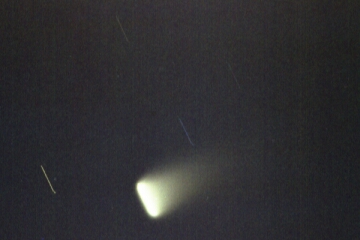

 The top two images here are scans of a couple of the negatives, clearly taken on different days as, due to the motion of the comet, the stars are not in the same places - they are probably not even the same stars. I haven't been able to identify which stars they are, because of the considerable uncertainty as to dates. The comet itself looks rather odd (and the stars are streaks rather than dots) because I used very long time exposures for the images, hoping to ensure I at least captured something: if you're using a film camera you can't preview the image and immediately have another go if there's nothing there! The strategy succeeded in capturing a good impression of the comet's tail though, so I think I deemed the shots a success at the time.
The top two images here are scans of a couple of the negatives, clearly taken on different days as, due to the motion of the comet, the stars are not in the same places - they are probably not even the same stars. I haven't been able to identify which stars they are, because of the considerable uncertainty as to dates. The comet itself looks rather odd (and the stars are streaks rather than dots) because I used very long time exposures for the images, hoping to ensure I at least captured something: if you're using a film camera you can't preview the image and immediately have another go if there's nothing there! The strategy succeeded in capturing a good impression of the comet's tail though, so I think I deemed the shots a success at the time.
It's also noticeable that the image of the comet is very much larger in these pictures than in the somewhat similar ones of comet PanSTARRS (below). This isn't because I took an enlarged scan of the negatives, but mainly because the effective magnification in these shots is greater than that with the digital camera as I had a "longer" lens available with the film camera - up to 1200mm in fact, compared to just 200mm with the digital camera (the digital will produce "interpolated" images up to 800mm, but the quality is not always good). In addition, Hale-Bopp was much brighter than PanSTARRS: this has caused at least the head of the comet to be somewhat over-exposed which, together with the extra effect of the time exposure, has resulted in a larger final image size.
The third image is a constructed one, made by taking slices from both edges and the middle of one of the comet "streaks" and merging them together. I did this in order to give an impresssion of what the comet might have looked like if I had been able to track it during the time exposure. While therefore not "real", it does show how much of the tail the long exposure captured.
 © Copyright Roger A. Firth 1997 and 2013 | Having discussed Hale-Bopp with Roger over the course of several emails he had a further ferret round and discovered another pack of negatives, from which this outstanding shot is taken. It shows the characteristic double tail of Hale-Bopp, the white one being the dust tail (which points along a comet's orbit) and the blue one the ion tail (which points directly away from the Sun). The group of stars in a (tilted) "W" shape to the right is the constellation of Cassiopeia, while those forming the sort of "T" or "Y" shape to top left are in the constellation of Perseus. Roger believes the picture was taken at Alport Height, nr. Wirksworth, Derbyshire: a very dark site apparently. Despite what one might imagine from the excellence of the shot, he says it was taken on an old Olympus 35mm viewfinder camera belonging to his grandfather, with exposure etc. all rather down to guesswork. Some people are better at guessing than others, it would seem! By comparison with my planetarium program I can say with considerable confidence that it was taken at around 9:10pm BST on the evening of 31st March 1997. |
| I'm not entirely sure why I didn't attempt a similar shot as I do remember the comet very well, hanging over the Waveney valley as I travelled to Beccles. However, I was rather occupied with the current stage show of my Opera Group at the time, so may not have been home at the appropriate hours of the evening. Some things never change! | |
Very occasionally, a comet may suddenly get brighter for no apparent reason and this may bring it to visibility when it is well-placed for viewing. At the end of October 2007 comet Holmes (no connection, unfortunately!) did just this, brightening by a factor of about half a million! Telescopic observation showed a rapidly expanding dust cloud around it, presumably caused by some sort of explosion. It seems this isn't the first time it's behaved like this: it was also unusually bright when it was discovered in 1892. I didn't get to hear about it until after the initial outburst but, given the name of this comet, I was very keen to image it - this section documents my results.
 |  |
| Comet Holmes (top left of centre) is here seen against the stars of the constellation of Perseus in early November 2007. The brightest star (near the top, just over 1/2 way across) is Alpha Perseii, often known as Mirfak. | An increase in magnification begins to show us the fuzzy nature of the comet, particularly noticeable compared to the points of light that are stars. The bright star towards bottom right is Delta Perseii, that somewhat above it is Psi Perseii. |
 | 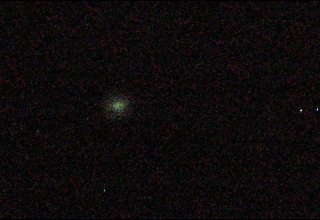 |
| As we zoom in further, it becomes obvious that the comet has a dense bright core surrounded by a less bright halo. Note that the orientation here is slightly different from the images above (compare the pair of stars to the comet's right) | A final increase in magnification shows the structure well. The halo has been increasing in size since the original outburst and is about half the diameter of the full Moon in this image, taken on 5th November - the day of closest approach to the Earth. No cometary tail had developed at this time. |
 | 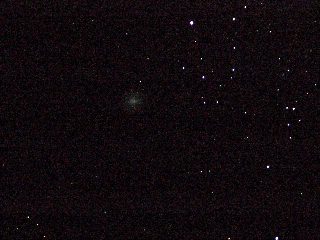 |
| Three days (left) and six days (right) later, it is clear that the comet has moved considerably. These images have the same orientation as those in the first row above but are centred slightly further up on each occasion, so Mirfak has re-appeared at the top of the second image. | |
 | |
| This composite of images [matched for brightness] from 5th, 8th & 11th November, plus one from 13th, shows the comet's movement well. It also shows that the "core" of the comet becomes fainter as time goes on while the halo gets slightly larger (see below). | |
 | 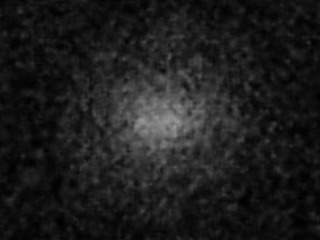 |
| A highly expanded composite image of two shots of the comet on 5th November (converted to black&white) showing the bright core and less bright "halo". | A composite from 8th November - it is clear that the core has dimmed while the halo has expanded. I'm glad to say this is a real effect, supported by professional pictures, not just an artefact of my digital processing! |
 |  |
| A further composite, this time from 11th November shows the core getting ever dimmer and the halo continuing to grow. | By the time we get to 13th November the halo has expanded to fill the frame. Note the two stars shining through the halo. |
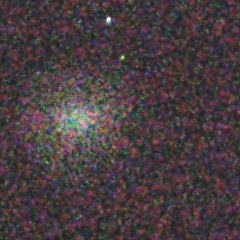 |  |
| A less-expanded, and enhanced, view from 11th November (left-hand image) shows some (slight!) evidence of a cometary tail - note the 'fish-tail' asymmetry of the halo to the right. The tail would be difficult to see, however, as (very unusually for a naked-eye comet) the Earth was almost exactly between the Sun and the comet - any tail there might be would thus be pointing directly away from us and hence be masked by the comet itself. However, the long-exposure image on the right (13th November) clearly has a less well-defined right margin than left indicating that this is definitely the direction any tail would emanate from. | |
 |  |
| By 13th November the overall brightness of the comet had decreased to such an extent that images taken at the previous exposure did not show much structure (see left-hand image). I thus changed to taking very long exposures (30sec, at 100ASA equivalent) which caused the stars to "streak" but captured good detail in the comet (though probably somewhat affected by the long exposure). The right-hand image is a composite of views taken on 13th to 16th inclusive and shows the decrease in brightness well, together with the continuing increase in overall size. | |
 |  |
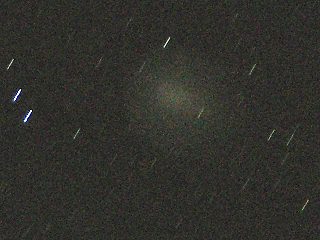 | After several dismal days of cloud and rain I finally got my next glimpses on 21st, 23rd and 26th November (top left, top right and bottom left images respectively). The comet had dimmed and expanded so much it was hard to see even in binoculars - these images are enhanced. Even by the 21st the halo had grown to over 35minutes of arc - wider than the full Moon, in fact - while the core became less and less noticeable. Conversely, by the 26th there was definite evidence of a tail (to lower right). These images also show why the comet became known as "The Jellyfish". |
 |  |
| Following yet more bad weather, these are the final images I captured, on 3rd and 5th December. By this time the comet was huge but so diffuse it was effectively invisible to the digital camera even at its maximum exposure: these images are enormously enhanced (as can be seen by their poor quality, especially the last one). The tail had continued to grow, however, with the halo itself reaching 45minutes of arc (11/2 times the diameter of the full Moon). After this, I occasionally observed the comet with the naked eye and in binoculars but for all practical purposes for me the fun was over. Just another 115yrs to go before the next outburst!! | |
This section deals with a much more "normal" comet - Lulin. While comet Holmes is periodic, Lulin is not and so its appearance in 2009 is the only time it will be seen. It was considerably less bright than Holmes (no explosions!) so imaging it was much more difficult. Weeks of cloudy skies didn't help, either! I did manage to see it in binoculars several times and image it on a couple of consecutive days though, so was pleased not to have missed it completely.
Although I described Lulin as "normal" above, it was unusual in one respect in that it moved across the sky extremely rapidly. A number of factors came together to cause this. Firstly, Lulin was relatively close to the Earth - just 38 million miles on 24th Feb. 2009. Secondly, it was near to the Earth only just after its point of closest approach to the Sun, when it would have been moving most quickly in its orbit. Thirdly, its speed was inherently slightly greater than that of a periodic comet at a similar distance because its orbit is hyperbolic not elliptical. Fourthly, the time of closest approach was quite near the date when the Earth was also closest to the Sun, and thus moving quickly itself. Finally (and most crucially) Lulin's orbit is in the opposite direction to that of the Earth: their relative speed is thus the sum of two speeds which are themselves almost maximised at this time. The result was a motion of almost 5 degrees per day at closest approach. Contrast this with comet Holmes, which when I observed it was four times as far away; five months after closest approach to the Sun, and orbiting in the same direction as the Earth.
 | This image is a composite of the two wide-angle shots I took to ensure I was looking in the right place, with rectangles overlaid to indicate the area of the actual comet images shown below (I've also added in grey blobs to represent the comet - it wasn't visible at this scale or exposure). The stars are all in the constellation of Leo (The Lion) and form the lion's left-front paw. The brightest star in the constellation (Regulus - the lion's heart) is out of the frame, a short distance away to bottom left. There is only 1 day between the two images but in this time the comet has moved about 41/2 degrees - nine times the width of the full Moon! |
 |  |
| And here we have the comet itself, on 28th February and 1st March. Each image is a composite of several individual frames, some at different exposure durations (thus accounting for the odd shape of the star trail in the first image!). The brightest stars are 23 Leonis (magnitude 6.43) and 7 Leonis (magnitude 6.31) respectively i.e. nominally less bright than the comet itself (magnitude 6.1). However, because of the diffuse nature of the comet and the very small size of its "core", it appears much dimmer than them. The colour-speckled backgrounds are simply due to camera noise at the sensitivity and exposure necessary to capture the comet, accentuated by the considerable contrast enhancement needed to see it in the image at all. The greenish colour of the comet "halo" is a real effect, however, caused by the presence of certain chemical compounds which glow this colour when excited by radiation from the Sun. | |
| I said above that Lulin moved very rapidly across the sky. I didn't realise just how rapidly until I started to "stack" the various frames to construct the composite for 1st March above. While some frames aligned nicely, others didn't: even after allowing for shifts in position due to the movement of the stars caused by the rotation of the Earth, the comet simply wasn't in the "right" place. I eventually realised that 4.5 degrees per day equates to about 5.6 minutes of arc per half hour: quite significant if your field-of-view is only 60 minutes of arc! (i.e. 1 degree). The image to the right is a composite of images taken half-an-hour apart (a stack of two in each case), showing that the comet did indeed move really rather a lot! Calibrated against the distance between the two fainter stars in the image (just over 6 arc-minutes), the shift is exactly as expected from the above calculation. A veritable celestial greyhound! |  |
This particular "comet McNaught" is just one of the many discovered by R.H.McNaught at the Siding Spring Observatory in Australia - its full designation is C/2009 R1 McNaught. The "C" means it is non-periodic, "2009" is its year of discovery and "R1"means it was the first to be discovered in the 17th half-month of the year (as the letter I is not used) i.e. the first half of September.
Like comet Lulin, McNaught was non-periodic but unlike Lulin its orbit was in the same direction as that of the Earth. It was also about three times as far away at closest approach - on the opposite side of the Sun from the Earth, in fact. This meant that while it moved across the sky reasonably quickly it was nowhere near as speedy as Lulin, which made obtaining a set of overlapping images from which to construct a composite rather easier than with Lulin. Its path across the sky meant it was rather low down in the north, however, meaning it would be well after midnight in the middle of the month before it was high enough to be seen adequately well. Conditions were reasonably good around then fortunately, with not too much cloud, so I managed to get three good images and observe the comet through binoculars for several days afterwards.
 |  |
 | The three images here were taken on 15th, 16th & 17th June. The orange-yellow star to top right on 15th June is Sigma Persei, while the bright one near the centre is Delta Persei (which also featured in the images of comet Holmes, though in a different orientation). Comet McNaught itself is the slightly greenish "star" exactly in the centre of the frame, below and slightly to the left of Delta Persei. One day later it has moved to the bottom left of the pair of stars at upper centre (also visible to the left of the first image), and finally on 17th it is between the pair to mid-left: the pair at the left of the first image are now over to the right. Not dramatic, to be sure, as I opted to take a wide-angle view in order to include the same set of reference stars in each image - but it's definitely there! |
| This image is a composite, showing the three positions noted above - click on the image to add the dates. You should now be able to find the comet on the individual images! The movement on the second day is fractionally greater than on the first, reflecting the fact that the comet was nearing perihelion and thus speeding up. The actual distance is about 21/3 degrees per day - half that of comet Lulin. Although it was hoped that the comet would reach naked-eye brightness, it didn't get much above magnitude 6 in practice and so was never an impressive object. |  |
The popular name of this comet derives from the Panoramic Survey Telescope and Rapid Response System in Hawaii, a semi-automated sky-survey system intended to detect Near-Earth Objects (NEOs). These are mainly asteroids, but it also detect comets! The comet's formal name is in fact C/2011 L4. This indicates it is a non-periodic comet, the fourth to be discovered in the 11th half-month, i.e. the beginning of June, of 2011.
A couple of factors made comet PanSTARRS special - it passed very close to the Sun at perihelion and the Earth was quite near to it when it did so. This resulted in it being a much brighter comet than the others described on this page - a magnitude of about +1 at its best, in fact. This isn't as good as it sounds though as it had to be picked out from the evening twilight. While it was thus quite easy to see in binoculars (if you knew where to look!) it was a naked-eye object only from sites with very clear seeing conditions.
Having put on a good show for southern hemisphere observers in February, the comet became visible in the UK from about 11th March. Unfortunately, this was during a period of unseasonably bad weather which produced cold days and grey skies so prospects didn't look good. Overcast conditions meant I was unable to observe until 13th March, when a late-afternoon clearance provided an opportunity. I was due to be out that evening unfortunately but took binoculars, camera and tripod with me! This proved to be a good call as I was able to park up on the way and scan the skies just below the thin crescent Moon. And there it was! Just visible in a fortunate gap between the trees was this "smudge" with a clear head and tail. Out with the camera for a few shots before I had to continue my journey.
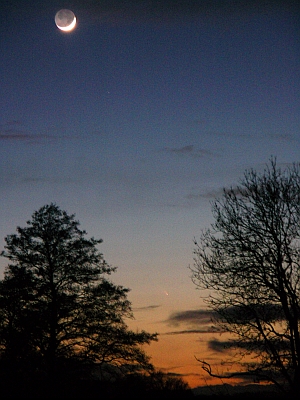 |  |
| Not only did the trees give me an easy way to keep track of where the comet was (as it was not visible to the naked eye), they also provided a very photogenic frame to the images! Together with the Earthshine-Moon to top left the whole composition was rather pleasing, I thought. The two images here show exactly the same view but a couple of minutes apart. If you haven't spotted the comet yet, it's between the trees just above the largest cloud-bank, on the boundary between the blue and pink sky colours. The movement of both Moon and comet in these few minutes is quite noticeable, showing how quickly an object near the horizon can disappear from view. | |
 | 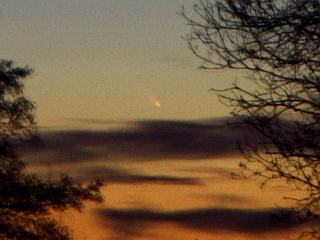 |
| But just in case you can't find it here's some enlarged views taken from the images above. The classic structure of a comet is clearly visible - the bright condensed "head" and the fainter more diffuse "tail" stretching out behind. | |
| To get a better view of the comet itself I created a composite image from the two above, together with one taken slightly earlier. I then enhanced the composite to try to bring out the tail rather more - it is difficult to capture it in a photograph taken at dusk as a longer exposure would just wash everything out rather than improve things. You might have to move your head around to see it better, but the tail reaches about as far toward the top left as the head is to bottom right. |   |
And for over a fortnight that was it, I'm afraid. The cloud (and snow!) returned, making observation impossible, and of course the comet itself was becoming dimmer as it moved away from the Earth while the Moon was getting steadily brighter, making seeing the comet much more difficult. Add to that the biting east wind, making being outside at night with binoculars a hazard to health, and it's no surprise that no further observations were forthcoming.
Eventually, however, skies did clear for a few days and with the Moon rising later as it went past full it was possible to have a further go at comet-spotting. Naturally, it turned out that I was not at home on most of the clearest evenings but I did manage to get some shots on a few nights.
 | The first opportunity was on 30th March, from home. Because PanSTARRS was by this time quite faint I could not pick it up for certain with binoculars in the twilight so adopted the strategy of taking a mosaic of fairly wide-angle images with the camera pointing in the correct general direction, with the hope that the comet would appear on at least one of them! Thankfully, it did - though nothing like as spectacularly as in the above images. The best view is shown on the left - PanSTARRS is the fuzzy "star" slightly down and to the right of centre. The head of the comet is clearly visible, and one can just about make out the tail extending upwards and a little to the right. Just for interest, the other stars in the image are as follows. The bright one to top left is Mirach, with those to its right (Mu and Nu Andromedae) being the two "pointers" to the Andromeda galaxy. In fact, the galaxy is just visible as a small, very faint, oval directly in line with Mirach and Mu Andromedae and to the right of a line between Nu Andromedae and the faint star below it. Those to the bottom-left of the comet are Delta and Pi Andromedae respectively and the pair to the right are Sigma (below) and Theta (above) Andromedae. |
| The next clear-sky opportunity arose a couple of days later but, inevitably, I wasn't at home that evening! I did manage to nip out of my rehearsal at coffee break though, but observing conditions were not good - low elevation, sky-glow and a bright sodium light nearby. I thus adopted the "mosaic" approach again, this time much more in hope than expectation. PanSTARRS was good to me, however, as it did (just about) appear in one frame. Mind you, if you thought the 30th March view was unimpressive..... I have thus not shown it here in full, but instead chose to use a portion of it, image processed to show things as clearly as possible and scaled & rotated to line up with the enlarged version of the 30th March image shown on the right. Click on the image to overlay the second image, click again to remove it. You should be able to see the comet move up and to the right from its initial position slightly to the right of centre at the bottom of the frame - it might need a few goes to spot it though! The two positions are exactly where my planetarium program indicated the comet should have been, so I am entirely confident that I managed to capture it on both occasions. |  |
 | My next, and last, imaging session was on 6th April, when a) I was at home, b) the sky was nice and clear, and c) the east wind had dropped, thus allowing me sufficient time in the open to take a considered series of shots (though suitably togged up with two pairs of trousers, three jumpers and a woolly hat!). PanSTARRS had by this time moved much higher in the sky but was down to magnitude 5, so although it was nicely seen in binoculars the photographic images still needed quite a bit of enhancement. I felt this was worth doing though, as PanSTARRS was quite close to M31, the Andromeda Galaxy (as mentioned above). The image on the left (a "stack" of several individual images) shows them both - M31 down and to the left of centre and PanSTARRS up and to the right. By comparison with the images from 30th March you will see that the bright star to mid-left is Nu Andromedae - none of the other stars have common names. The comet's tail is much more obvious in this image than those from 30th March, as the magnification factor is greater - see below for an even better view. |
 | The magnification in this image is over 4 times that in the one above so, despite the reduction in image quality due to electronic noise in the camera sensor, it does show the comet's tail quite nicely. Note that it is pointing in an entirely different direction from the 13th March image. In those 24 days the proper motion of the comet across the sky has taken it from "left" (i.e. south) of the point at which the Sun sets over to the "right" (i.e. north). The tail of a comet always points towards the Sun, and so it has swivelled round in order to keep doing so. I didn't attempt to observe PanSTARRS after that as it was getting ever fainter with each passing day so any images would have been quite hard to capture. Still, I was very glad to have had the opportunity to take at least some good shots. |
And as to why I was unable to match the picture of comet Hale-Bopp shown at the top of this page, there are three "astronomical" reasons and one bit of bad luck. Firstly, Hale-Bopp was much brighter than PanSTARRS: magnitude -1.8 at its brightest compared to +0.8 for PanSTARRS - a factor of 11. This made an enormous difference to the ease with which it could be photographed. It was also much higher in the sky when at its brightest. This meant it set later, enabling it to be well seen against a fully-dark sky rather than in the twilight. For example, when I first saw PanSTARRS it was only 12deg high at 7pm whereas Hale-Bopp was still 24deg high at 9pm on its brightest day. Next, PanSTARRS reached its absolute maximum brightness when still below the horizon for UK observers and so was dimming all the time. Conversely, Hale-Bopp reached its maximum brightness while in the north and so stayed bright for a much longer time. In fact, PanSTARRS had decreased below magnitude +2 in less than a week whereas Hale-Bopp was still at magnitude -0.8 a month before and after maximum. Finally, the bad luck - as mentioned above, the weather was not exactly favourable, with cloudy skies for most of the critical period. All in all then, I felt I had done quite well to get the images I had!
As with the several comets known as "McNaught", this particular comet Lovejoy is just the most recent one of the five discovered by Australian amateur astronomer Terry Lovejoy from his observatory in Brisbane - its full designation is C/2014 Q2 Lovejoy. Lovejoy is a very-long period (~10,000yrs) comet whose orbit is inclined at 80deg to the plane of the solar system. It had a spectacular tail visible in long exposures (but these need a guided mount, which I do not have) and a very distinct blue-green "head" due to the presence of ionised carbon monoxide (CO+) and diatomic carbon (C2), which was much more easily seen.
Initially only visible from the southern hemisphere, it moved into our skies in December 2014 and achieved maximum brightness on 10/11th January 2015 when it was situated directly to the west (i.e. right) of Orion, below the Hyades and Pleiades clusters - ideally placed for observation. The weather was not very kind to me though as, despite several clear nights just before the comet became visible, in the critical period of the first week of the New Year cloud (and indeed the presence of a Full Moon) precluded any photographic observations, though I did glimpse it once in binoculars. Skies were fortunately clear on the night of maximum brightness though, so I was able to take a series of images. As the weather forecast was rather poor, I decided to go for multiple observations on the same day and so took three series during the evening.
 | This is the "orientation shot"! The well-known constellation of Orion is off to the left of the picture, with the arc of stars to mid-left being either his shield or a lion-skin draped over his arm (depending on which illustration you prefer!). The cluster near to top left is the Hyades, with their major star Aldebaran, and the object to bottom right is a bit of the roof of my house! The pair of stars a fraction above dead-centre are the guides to the comet, which can in fact just be seen a little to the right of the lower one of the pair. |
 | The image here is a composite of three frames taken within seconds of each other at 7:40pm on 10th January. The stars to the left are the pair mentioned above: Nu (upper - mag. 3.9) and 40 (lower - mag. 5.3) Tauri. Comet Lovejoy is the distinctly greenish "star" just to the right of centre, nominally at magnitude 5.0 - it clearly doesn't look that bright, due to the fact that it is a diffuse object rather than the points of light which are the stars, which is the reason it didn't really become a naked-eye object. |
 | This is image is the result of my photography later in the evening: at 10:25pm in fact. I've rotated the resultant composite to the same orientation as the one above. It is quite clear that the comet has moved considerably in the 23/4 hours since the first observation: 1/3 of a degree, in fact. |
 | The final images were taken just after midnight, at 0:15am. Cloud was beginning to gather by this time, and the rising Moon was also not helping things. The frames were thus not so clear as those taken earlier and needed a greater amount of enhancement, explaining the lower quality of the composite (of just two frames this time): it has also been rotated to the same orientation as the first one above. It is again clear that the comet has moved since the previous observation, by a further 1/5 of a degree. |
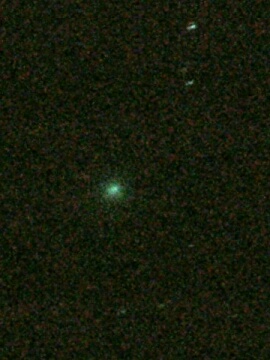 | And finally, a close-up view of the comet produced from frames taken at a higher resolution in order to preserve more detail. It has also captured more, fainter, stars: those adjacent to each of the stars to top right and the three below the comet are all at magnitude 9. While I was never going to see the tail, this view does emphasise the comet's vivid blue-green colour and condensed central region. |
Despite Lovejoy being much closer to the Earth when observed than Comet McNaught in 2010 (which partly accounts for its greater brightness), its rate of movement across the sky - 0.12deg/hr or 2.88deg/day - is only a little faster. This is because its orbit doesn't take it as close to the Sun at its nearest point, and so its actual orbital speed is inherently less than that of McNaught.
I was glad I had decided to take three series in the one night, as after that we were back to the old story of cloud, rain and strong winds. No observations were possible for about a week, therefore, but I did catch it again on the night of the 16th. I had by this time worked out a way to take rather longer exposures than previously, using the "bulb" setting. The handbook for the camera seemed to say that the maximum exposure with "bulb" was no greater than for a timed shot, but experimentation proved that this was not in fact the case: I was able to get about 15sec at 800ASA compared to the timed maximum of just 4sec. I had to use the remote control to avoid camera shake of course (as you have to keep the shutter release depressed with your finger all the time on bulb, and this tends to shake the camera), but the results were impressive.
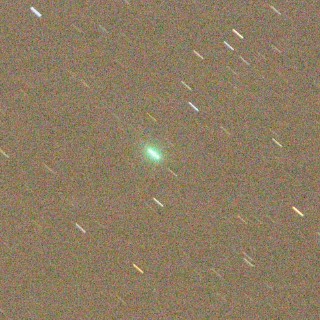 | However! While the image I was able to capture was much brighter than before, it was a set of "streaks" i.e. all the stars (and the comet) were lines of light rather than slightly-extended points, due to their greater apparent motion during the much longer shot. The problem with this is that the linear extent of the tail is at an angle to the direction of apparent motion (as it points directly towards the Sun) and so its image would have been "smeared out" by the motion rather than emphasised by it as is the case with the stars (see the section on Comet Hale-Bopp, above, for an example of this). I felt it was worth working with the images though, just to see if anything did appear but, as this image shows, nothing that could definitely be assigned to a tail could be seen, even when several shots were stacked (the image is in fact a stack of five frames, with levels adjusted to give the "normal" and "negative" images the same brightness histogram). If the tail had been visible it would have extended away close to the "11 o'clock" position from the comet's head, heading just to the right of the bright star to top left of the image. This confirms my statement at the beginning of this article, that to see the tail you need a much longer total exposure (either directly or by a stacking process) - the description of many superb shots on the Internet says they are stacks of several exposures of up to 2 minutes each! - and either a guided mount (to avoid the apparent motion of the comet "smearing out" the tail into a very low density streak) or some clever image-manipulation to reverse the streaking effect (which frankly I would regard as rather a cheat). Without a guided mount, your only option is a higher ASA number (if available!) but this can bring with it the problem of image noise. No easy answer then! |
Despite having no luck with the tail (and almost getting frost-bitten fingers that night!), I was content with what I had managed to capture. I observed Lovejoy in binoculars when I could after that but as it was slowly decreasing in brightness I didn't attempt any more photography as I felt I would not be able to improve on my previous "close-up" efforts and it didn't really get close enough to the Pleiades to give a spectacular shot. However, I was pleased to have added a further comet to my tally.
This comet was, like PanSTARRS above, one of many discovered by an automated system - in this case the Catalina Sky Survey, on 31st October 2013. Its formal name is C/2013 US10 - the "S" is there because it was initially thought to be an asteroid. Catalina came from the Oort Cloud, the tenuous swarm of icy bodies (remnants left over from the formation of the Solar System) residing way beyond even the orbit of Pluto, and initially had an orbital period of several million years. However, its pass through the planets has perturbed its orbit sufficiently that it is now on an "ejection trajectory" i.e. this is its first and only visit.
Its orbit is very highly inclined with respect to the plane of the Solar System (59deg) and retrograde i.e. the comet orbits in the opposite direction from the planets. This is both good news and bad news - retrograde motion will generally mean that there will be two occasions when the comet is close to the Earth (once on the "inbound" journey and once "outbound") but also that its speed relative to the Earth will be high and so each observing season will be quite short. In the case of comet Catalina, the inbound encounter was on 14th August 2015 at a distance of 1.089AU (astronomical units - the distance from the Earth to the Sun) at magnitude 7.6 and the outbound was on 17th January 2016 at a distance of 0.725AU and a magnitude of 6.5. It was at its brightest on 3rd November 2015 at magnitude 6.0 (when 1.808AU from the Earth). This was just before its closest approach to the Sun on 15th November, thus accounting for the increased brightness despite the greater distance.
Initially visible in the early morning, it moved into the evening skies in early January 2016 and rapidly gained altitude as it headed for the handle of the Plough (Ursa Major). A combination of bad weather and ill-health meant I could not observe until the middle of the month, when I got an opportunity on the 17th. This, you will note from the above information, was exactly the day of closest approach - a pure coincidence rather than forward planning, however! The comet was barely visible in binoculars but was captured well by the camera despite some slight high cloud. Due to the extreme cold that night I just took the one set of images and then beat a hasty retreat to avoid frostbite!
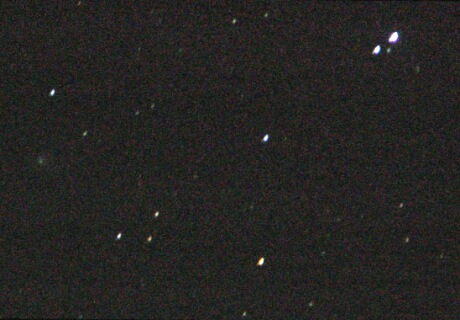 | The pair of bright stars to top right are Mizar (upper) and Alcor (lower), the well-known double star in the middle of the handle of the Plough. They are actually a true pair, orbiting each other about once every million years. The third star, which rejoices in the unusual name Sidus Ludovicianum (!), has no connection with the Mizar/Alcor pair at all - it just happens to lie in the same direction in the sky. Those close to the centre are 81 (upper) and 83 (lower) Ursae Majoris - all the rest just have reference numbers rather than constellation names. Comet Catalina is to be found close to the left-hand edge, half-way down - its fuzzy appearance and greenish colour are quite distinctive. |
 | I'm afraid it's no more dramatic in close-up! As explained previously, to have captured its tail (in fact two tails, as the dust tail and ion tail were well separated) would have required a wholly different photographic technique. However, this image does show the difficulty of assessing a comet's brightness. Catalina was nominally at magnitude 6.5 here. This is about the same as the star well above it and slightly to the right, which is clearly visually much brighter. The comet is visually about the same as the pair in the upper-right corner, which are mag. 8.5 - a factor of 6.3 times less bright than the other comparison star. This is because a comet's magnitude refers to its very small core, not its full visual extent. It thus sends out relatively little light overall, which is the important factor for cameras and human eyes. The same effect is seen with galaxies. Although the Andromeda Galaxy is nominally mag. 3.4, which should make it an easy object in the night sky, it is actually only just visible to dark-adapted eyes. |
And that was it really. The next few nights were cloudy, and Catalina's rapid motion across the sky (about 2.7deg per day) meant that attempting a sequence of images several days apart to show its movement would not be particularly instructive as there would be few stars in common between successive images. I was thus content to tick this one off and wait for the next!
After a couple of false starts, when comets forecast to be bright turned out to have other ideas (in one case actually disintegrating!), we eventually got a good one in 2020. This comet was again one of the many discovered by an automated system, but this time by a system in space - the Wide-field Infrared Survey Explorer (WISE) space telescope re-purposed to detect Near-Earth Objects such as asteroids and comets (hence the NEO part of the comet's name). Its formal name is C/2020 F3, indicating it was the third to be discovered in the second half of March 2020 - 27th March, in fact. Like comet Catalina, its orbit is very highly inclined with respect to the plane of the Solar System (129deg) which means it is actually moving in a retrograde direction.
Its closest approach to the Sun was on 3rd July 2020, at just 0.30AU (a mere 27 million miles), with its closest approach to the Earth being on 23rd July at 0.69AU (64 million miles). Both of these distances are relatively small (in astronomical terms!) and so the comet was a naked-eye object for several weeks in July - brighter than PanSTARRS in 2013 (see above) but not so bright as comet Hale-Bopp in 1997. Its closeness to the Earth and its retrograde orbit meant that its proper motion across the sky was quite rapid - 3.6deg/day in fact - so only a couple of weeks after it became visible in the northern hemisphere's early morning skies it had passed behind the Sun and re-appeared in the evening: much more convenient for observation! Unfortunately, persistent cloud cover in the east of England meant I was only able to observe it over the course of just one weekend but I did get some good images before it faded as it sped away from the Earth. Its already long orbital period was lengthened even further by its encounter with the Sun so it won't be back this way for about another 6700 years!
 | The first night my skies were clear and Neowise was high enough in the sky for me to have a good chance of observing it was on 17th July. I knew the area of sky it should be in so scanned around with binoculars once conditions were sufficiently dark and eventually found it. I was pleasantly surprised how bright it was and how clear its tail was, extending upwards out of my field of view. Indeed, once my eyes had become dark-adapted I could see the comet clearly, if dimly, with no optical aid. Aligning my camera only took a couple of goes and then I was able to take this orientation shot. Comet Neowise, with its tail, is to bottom right and the stars over to the left are all in the constellation of Ursa Major, situated in the Great Bear's front left leg. The rightmost star in the triangle to the comet's immediate left (Talitha, Iota Ursae Majoris) is magnitude 3.1, and is about the same brightness as Neowise. This is consistent with published light-curves, which show it around magnitude 3 during the middle part of July. |
 | Having located the comet I then zoomed in so I could take a series of images and stack them together to simulate a longer exposure than I was actually able to take. This is a standard astrophotography technique, used to improve the contrast between the subject and the background and to reduce the effect of electronic noise generated by the camera sensor. Note that this image is not directly comparable to the one above, as both have been cropped to different extents from the original images - in fact, this one was taken with a 200mm lens setting, the one above at 100mm. Also, while that above is a single image this is a stack of four images, which will tend to increase the brightness of the comet relative to the stars - which is, of course, the whole point of stacking! |
The lower of the two images above shows the comet's tail very nicely, although to a lesser extent than was visible in binoculars. It also shows how it curves over to the right. The tail is made of dust continuously blown off the comet as some of its icy constituents evaporate under the action of sunlight. The solar wind coming from the Sun then pushes the dust away, with the result that the tail always points away from the Sun. Not directly, however, as the dust particles are also affected by the comet's orbital motion. The combined effect produces the curved tail as observed.
| Skies were cloudy on the 18th but cleared on the 19th, allowing me to take another series of pictures. As with the one immediately above, this is a stack of four images so it again makes the comet look brighter relative to the stars. It is, however, perhaps a little less bright than on the 17th. This is a genuine effect, as comets slowly become fainter as they move away from the warmth of the Sun because the amount of material evaporating thereby reduces. The triangle of stars at far left above is now at bottom right, showing how quickly the comet is moving - note that the distance between the two lowest stars of the triangle is twice the diameter of the Full Moon! This comparison also emphasises the extent of the tail. |  |
It is very noticeable that the comet's tail, though still curved, is now basically upright rather than being inclined to the right. This is because, while the tail always points away from the Sun (as mentioned above), the "away from the Sun" direction changes as the comet moves along its orbit. Newly evaporated dust therefore departs in a slightly different direction from day to day, resulting in an apparent rotation of the tail as seen from the Earth.
 | Conditions were still good on the 20th so I was able to make another evening excursion to the village allotments - purely because there's a good view of the northern sky from there! Again, this is a stack of four images. The triangle of stars is now no longer in the frame, as Neowise has moved not only to the left but also upwards, sitting now in the Great Bear's front right leg! Note that its tail has rotated further to the right as it continues along its orbit. |
 |
| The image above is a composite, constructed from the individual images above but with the comet shifted into the correct relative position for all three observations. It is clear that one day is missing, when it would have been within the triangle of stars mentioned earlier. Putting all three images in one frame shows even more clearly the rotation of the comet's tail as it moves along its orbit from day to day and the slight reduction in brightness as it moves away from the Sun (despite the fact that over the span of 3 days it is moving closer to the Earth). |
Poor weather conditions then set in, with the result that the skies were not clear again until 28th July. I was not particularly hopeful of obtaining any images, as Neowise had by then dimmed very considerably and the light from a waxing Moon was beginning to reduce the sky darkness. I did get a few though, two of which I stacked, cropped to the same scale as the earlier ones and adjusted to the same average brightness, so all images could be directly compared. The result is shown below.
 | While Neowise is still clearly identifiable (to right of centre), it is now a pale shadow of its former self. Its rapid motion has taken it right to the border of Ursa Major (to the Great Bear's outstretched left rear leg in fact) and nearly into Coma Berenices. The brighter star to its upper left is magnitude 4.96, and Neowise is a little less bright even than that. This is, again, consistent with published light-curves which show it at magnitude 5.0 to 5.5 at the end of July. This means it has become at least 6.3 times dimmer since July 17th. Its tail is still just visible though, rotated even more to the left as it continues to move round its orbit. And if you think you can see a streak across the centre of the frame, then you are right - I assume it must have been a passing satellite! |
| A further clear night on the 30th then persuaded me out for one final time (as bright comets don't come around that regularly) and I was able to get some images despite the increased interference from the Moon. I was keen to do so because of the interesting juxtaposition of a comet (derived from the Latin word for "long hair") and the constellation Coma Berenices or "Berenice's Hair". Neowise can be seen a little above centre, its tail still just visible, with the constellation stars forming an open rectangle to bottom left. Note the three-star grouping to top right, also visible in the image taken on the 28th. Having this feature in common enabled me to make another composite image, showing the position of the comet on both days. |  |
 |
| This second composite image shows the comet's position on the 28th & 30th, illustrating even more dramatically its great decrease in brightness since the previous observations. By comparison with its appearance on the 28th, and against the magnitude 4.96 star in the central triangle, it is clear that Neowise was definitely down to about mag. 5.5 on the 30th, again consistent with published light-curves. Attempting a "total composite" of all five observed positions would not have been practical, as the comet's rapid motion had taken it far from where it was 8 days before. |
 Image copyright © Comet Observation Database 2020 |
| And finally, the lightcurve I have referred to several times above, plotted until early August from visual and camera-based observations gathered from around the world. What a pity I was unable to observe when Neowise was (somewhat briefly) at peak brightness! |
Given that Neowise would continue to decrease in brightness and that the Moon would pose an ever-increasing problem I decided to call a halt to observations at this point. I was very pleased to have captured the sequence of images that I did though - here's to the next naked-eye candidate!
Although a few potentially promising comets arrived after Neowise, they were either only visible around dawn (not my best time of day!) or failed to live up to expectations so it was not until late 2022 that hopes begain to rise once more. Comet ZTF was again one of the many discovered by an automated system, in this occasion the Earth-based Zwicky Transient Facility - hence the informal name ZTF. Its formal name is C/2022 E3, the "E3" indicating it was the third to be discovered in the first half of March 2022 - 2nd March, in fact. Its orbit is almost perpendicular to the plane of the Solar System (109deg) and as that is greater than 90deg it should mean the comet is moving retrograde i.e. in the opposite direction to the planets. However! Because it is moving round its orbit "the wrong way" the large orbital inclination actually means its motion relative to the Earth is prograde! (i.e. the same way as the planets).
Its closest approach to the Sun was on 12th January 2023, at 1.11AU, with its closest approach to the Earth being on 1st February at a mere 0.28AU (26 million miles). Its closeness to the Earth meant it reached near naked-eye visibility during late January and early February but it was nowhere near as impressive as comet Neowise due to its greater distance from the Sun (which decreases the amount of dust etc. blown off it by the solar wind). The closeness to Earth did mean though that its proper motion across the sky was very rapid despite its prograde motion. It was moving at 5deg/day when I saw it but at closest approach it was going at 6.8deg/day.
The orientation of its orbit meant that the comet was initially visible only around dawn but observers confirmed that it did seem to be brightening according to predictions (not always the case) and so I had hopes that it should be a good object when it emerged into the evening skies early in the New Year. I had to wait many days to find out though as, inevitably, we had almost continuous cloud cover in the east of England which meant I was only able to look for it as late as 27th January.
 | Comet ZTF is to right of centre - yes, that small greenish blob! As my pictures of comets before Neowise show, very few show visible tails even in binoculars. Professional images will do so of course, but they use very long exposures with systems which track the comet across the sky. The bright star to mid-left is Kochab, the brightest star in the "bowl" of Ursa Minoris, the Little Bear. The left-most of the pair of stars to bottom left is Pherkad, which together with Kochab forms the side of the bowl, whose "handle" arcs up to Polaris. |
 | The image above was taken at about half-past 7. I wanted to get some more images though, so went out again a couple of hours later and captured this one. Having done so, I realised that the comet was not in the same place! It had moved from the bottom of the arrow-shaped group of stars to the top. At the time I hadn't realised it was moving quite so quickly, so this came as a considerable surprise. The entire sky had also moved round of course, due to the Earth's rotation, so for a better comparison of the comet's positions I rotated & aligned the two images and zoomed-in on the comet and just the stars immediately surrounding it. |
 | This is the result for the first picture. The arrow-shaped group of stars is now much clearer. Click or tap on the image to see the situation two hours later. Quite a dramatic shift, I think you will agree. In fact, in the 2hrs 6mins between the two images the comet moved 26 seconds of arc, which (as I mentioned in the introduction) equates to very nearly 5 degrees per day - ten times the diameter of the Moon! |
Cloud then returned, not helped by a waxing Moon adding its light, so I wasn't able to see the comet again until 6th February. Normally, a time interval of 10 days would be sufficient to shift a fast-moving comet right across the sky but a unusual quirk of ZTX's orbit meant it was still conveniently placed for observation - during this period the comet was actually circumpolar. In other words, its track carried it in an arc round the Pole Star rather than in a straight line across the sky - "upwards" and to the right of Polaris in late January, horizontally and "over the top" as the month changed, and then downwards and to the left during early February. So, when I was able to pick it up again it was not all that far from where I had first seen it. Even better, having started out being easy to spot between the Little and Great Bear it had headed into an area containing more easily-recognised star patterns which made it quite easy to find each time (in binoculars initially) despite getting gradually less bright.
 | On 6th February, the comet was at the base of the triangle of stars known as the Haedi, or Kid Goats - so called because of their proximity to the star Capella (Alpha Aurigae) whose name means "Little Goat". In this image, Capella is the very bright star at the top of the frame and the bright star directly below it is the apex of the Haedi triangle. The other two "Kids" are the bright stars 45 degrees down and left of the apex star. The comet is the greenish patch to the right and down a bit from the star closest to the other two. Found it? |
| All the above images have been processed with the excellent SmartDeblur v1.27 program to remove the star trails caused by the rotation of the Earth during the long exposure. However, while doing this I noticed that the trail left by the comet was not quite at the same angle as those left by the stars. I realised that this was because of the comet's "proper motion" across the sky during the exposure but was surprised it was so noticeable. As mentioned above, I knew the comet was moving quickly but hadn't expected its motion to be apparent during just a 30 second exposure. | |
 | It would have been impractical to clearly show the motion over just those 30 seconds so I selected two shots from my observing session that night, one at the start and one at the end, as I had done for 27th January. I then rotated and aligned them, and cropped them down to show the area around the comet more clearly. The result is shown here. Click or tap on the image to see the shift in position over only 15 minutes. This shows why "professionals" find it necessary to track the comet rather than just the general motion of the stars when carrying out a very long exposure. |
| I then had the remarkable good fortune to have clear skies for the next four evenings in succession, enabling me to track ZTF as it descended in the sky towards Mars. Here is the view on 7th February. The comet can be spotted in the lower-left quadrant of the image, just to the left of an upright triangle of brighter stars. The Haedi, where it was the day before, can be spotted to top right. |  |
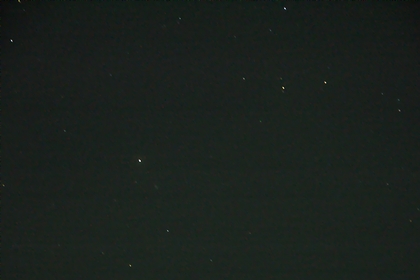 | Now when I said "clear skies" above, I was perhaps being a bit generous about the situation on 8th February, when "not entirely cloudy" might have been a more accurate description. I persisted with my photography though and was rewarded with just a faint view of the comet. In this image it is at about the "5 o'clock" position down and to the right of the brightest star at the head of the offset triangle of stars in the bottom left quadrant. Not obvious, but that is indeed it! The triangle where it was the day before sits to top right. |
| Clearer conditions returned on the 9th, with the comet marking the left-hand arm of the T-shaped group just to the right of centre near the bottom of the image. The triangle of stars where it was the night before are now seen rather more clearly to top right. |  |
 | And finally, we have the situation on the 10th, the last clear night I was given. It was a suitable end to the sequence though as by this time the comet had reached Mars - the very bright object at the bottom of the image. The comet itself is just below centre, directly above Mars, with the group of stars it was next to on the previous night being the "dog-leg" triangle to top right. |
After that, not only did the skies cease to assist my observations but the comet itself was rapidly getting less bright and descending further towards the horizon, thus making any further views more uncertain even if skies had been clear. I thus decided to cease my "ZTF project" at this point. Not the most dramatic of comets, but still interesting to track round the skies.
I wasn't going to include Pons-Brooks initially, as I wasn't able to get many images of it, but decided to do so because it became quite famous in connection with the total solar eclipse of 2024 - see below! The comet's formal name is 12P/Pons-Brooks as it is a periodic comet with a return interval of 71 years, discovered in 1812 by Jean-Louis Pons and at its next apparition in 1883 by William Robert Brooks. It is one of the brightest known periodic comets, prone to sudden outbursts which cause it to brighten by several magnitudes before settling back again. It didn't get bright enough for me to attempt to see it until well into 2024 though, and by that time it was heading towards the western sky at sunset and so could not be seen against a really dark background. Then there was the weather to contend with of course, not to mention the many musical activities that tend to occupy my evenings!
I was able to make my first observation on 24th March but this was slightly haphazard as, because of the lightness of the sky, I wasn't even able to see many stars let alone the comet so aiming the camera was somewhat problematic. The only real guide I had was the planet Jupiter, which was shining brightly in the evening sky at this time. My astronomical program, C2A, told me that the comet was "down and to the right" of Jupiter, so that's where I aimed!
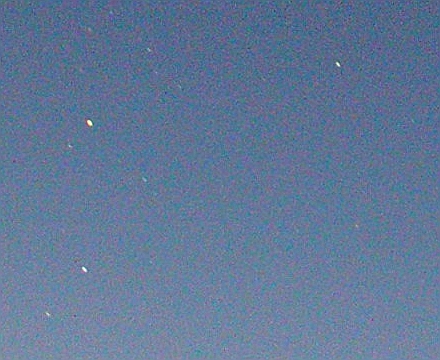 | And this is the somewhat zoomed-in view of what I saw. The two bright stars in a vertical line to the left are Hamal (upper) & Sheratan (lower), the major stars in the constellation of Aries, and the one to upper right is Elmuthalleth, the star at the apex of the constellation Triangulum. If you look carefully about the same distance below Elmuthalleth that Sheratan is below Hamal, and fractionally to the right, you should see a faint spot. This is comet 12P/Pons-Brooks! If you're not sure, click or tap on the image to add a yellow circle round the comet. If you click again this view will expand up to be closer to a naked-eye view, which should help to place everything in the night sky. The planet Jupiter is of course to upper left, the full extent of Triangulum can now be seen above the yellow circle, and the bright star to centre right is Mirach, in Andromeda. Click once again to see a star map produced by the astronomical program C2A which clearly shows that the comet should be in the position marked by the circle |
| And that was it for almost a week, until I had my next opportunity to observe on 30th March. By this time the comet had moved "up & left" about one-third of the way towards Jupiter, which put it squarely within the constellation of Aries. In fact, it is now very close to Hamal - just to the right and down a bit. See it? As before, click or tap on the image to add a yellow circle if you're not sure and again to change to a slightly wider-angle view. This one is "zoomed in" quite a bit as compared to the previous wide-angle view but I'm sure you'll recognise Triangulum to upper right and of course Jupiter to mid-left. Click once again to see a star map, which again clearly shows that the comet should be in the position marked by the circle |  |
Another week passed before I made my next observation, but this one wasn't in the UK! As documented elsewhere, I had flown off to Texas to observe a total eclipse of the Sun on 8th April which, by coincidence, would happen with the Sun in Aries. Well - astrologically speaking anyway, as the star sign of Aries is defined as being from 21st March to 19th April. In fact, because of the cyclic "wobbling" of the Earth's axis of rotation (called axial precession) over a period of about 26,000 years, all the star signs have now "moved back" one. Therefore the Sun would actually be in the astronomical constellation of Pisces during the eclipse. However, it would still be quite close to the areas shown in the images above (somewhat to the south-west in fact - "down & right, in geometric terms), so Jupiter and the nearby comet would be within a convenient field of view during the eclipse - 30 degrees "up & left. This would be far enough away from the Sun to allow Jupiter to be easily visible but the situation with the much less bright comet was rather more uncertain. I thus decided to see whether I could capture the comet as it was setting the evening before, just in case it was not visible on eclipse day
 | Unfortunately, the weather conditions prior to the eclipse had not been good, with much cloud cover. Also, the hotel where I was staying was surrounded by roads with bright streetlights and by the time the sky was dark enough to attempt any photography the comet was quite low down in the sky. There was no chance of seeing it by eye, therefore, so I just had to go by the position of Jupiter (which was easily visible) and fire off a few shots to see what I could capture. Happily, I found I had aimed in the right direction and had indeed managed to image the comet - if only just! The image on the left shows an enhanced and cropped version of my best frame, with 12P towards bottom right and of course Jupiter at top left. I think it's clear that this really is the comet, as there's even a suggestion of an upwards-pointing tail. Just to confirm this, click or tap to see a star map of the relevant area. The four brightest objects other than Jupiter and the comet are 5th and 6th magnitude stars in the constellation of Aries. As it turned out, no-one in my party managed to image the comet on eclipse day so I was very happy that I had succeeded the evening before |
But is that really it, I hear you say? Well no, not entirely because I did in fact take more images on the 30th. Once I had found the comet in a reasonably dark sky I could zoom in further and take a number of exposures so I could stack them together and thus get a better contrast in the resultant image.
| On the right is a typical zoomed-in image once cropped to size and aligned with all other similar images. The stars are now trails rather than dots because of the long exposure used (about 30sec). You will recognise the grouping of Hamal and Sheratan and the less-bright stars around them from the earlier wide angle views, and therefore will be able to deduce that the comet is the faint greenish streak down and to the right of Hamal. Click or tap to see what happens when three such images are stacked, and again to see the resultant image when enhanced. Many more stars are now visible and the comet is unmistakeable, with its very obvious tail. A green-coloured comet is quite common, by the way, this colour being caused by emissions from diatomic carbon and cyanogen in their nucleus, so I wasn't surprised that this one came out green also |  |
 | I have mentioned the very useful program SmartDeblur several times in these cometary write-ups so let's see what it can do in this case. Click or tap to find out! Pretty good, eh? Now I must admit that this is the result of a bit of a "tidy up" after SmartDeblur has worked its magic, but nothing major. The rather serious downside is that the comet's tail is nowhere to be seen, probably because it is a very faint feature and thus doesn't survive the "smoothing out" of the background which SmartDeblur performs after processing. I mentioned this to my school-chum Roger, who is also into "photoprocessing" and he said he'd have a go at restoring the tail. He assures me he didn't do anything "naughty", picking up the details of the tail from clues in the images, but I'll leave you to click again and judge the result for yourself! |
And that was that really, as my musical endeavours took up most of my evenings for quite a while after returning from Texas and in any case 12P was rapidly heading for the horizon and so became effectively unobservable after about another week. I thus looked forward to the arrival of the next visitor from the deep reaches of space - which turned up quite soon afterwards in fact!
The full name of this comet is C/2023 A3 (Tsuchinshan - ATLAS), reflecting its discovery by the Purple Mountain Observatory in China in January 2023 and independently by the Asteriod Terrestrial-impact Last Alert System a few weeks later. It was named "The Comet of the Century" by the media, as hopes were high that it would become a naked-eye object in September & October 2024 when it would be at its least distance from both the Earth and the Sun and, just for once, the predictions came true. Well - sort of. Because its closest approach to the Earth was when it was also near the Sun in the sky, although it became very bright at that time (some estimates saying it was magnitude -4 or brighter) it was effectively unobservable. By the time it had moved far enough away from the Sun to be observable its brightness had decreased considerably, down to around magnitude 2 in fact. An object of this magnitude would be very noticeable in a dark sky - about the same brightness as Polaris - but as the comet was still reasonably close to the Sun it was seen low down against a twilight sky thus making it a more difficult object.
From the northern hemisphere comet ATLAS was initially visible at dawn but moved into the evening sky as it passed behind the Sun, becoming observable again from about 10th October. Due to "adverse observing conditions" (for which read "cloud"!) I was unable to try to see it until 14th October, when I donned the usual extra layers, found the binoculars and took the camera & tripod up to my usual viewing site. I did so quite early, on the basis of advice from pundits that the comet could be seen about half an hour after sunset, but this was clearly untrue as the sky was still much too bright. Time dragged on with no sign of anything but despite getting progressively colder I persisted with my vigil and was close to giving up for the evening when I was sure a could see a faint smudge in the right place. And so it proved - the view through binoculars confirmed that it was the comet.
 | And here we have my first view of the comet, at 7:20pm. The brighter of the two stars just visible to top left is Unukalhai, formally known as Alpha Serpentis. I used the know magnitude of this star (2.7) to estimate the magnitude of the comet and came up with the result 2.2 - exactly as per predictions. And if you are thinking that the image could do with being a bit sharper than you are absolutely correct. While waiting for the comet to appear I had not noticed that mist was gathering over the fields, condensation was appearing on the camera and that the lens was beginning to mist up - hence the rather "soft" appearance of this image. |
| Having wiped the lens (!), here we have a more wide-angle image showing, to right of centre at the top, the distinctive shape of Corona Borealis the Northern Crown, and to its left the upper, brighter, star of the vertical pair is Kornephoros (Beta Herculis). The bright star at right middle is Arcturus (Alpha Bootis) with Izar (Epsilon Bootis) above it. The pair of stars visible in the image above, pointed to by the comet's impressive tail, can also be seen in this view. |  |
 | And talking of the tail, the image on the left is a stack of three close-up views which has been heavily enhanced and converted to greyscale in order to show the extent of the tail, which actually extends as far as the pair of stars - a distance of 14 degrees. If you look carefully you will see a tiny "spike" sticking out of the head of the comet in the opposite direction to the tail. This is not a processing artifact, as can be seen by the image on the right which is a further stack, this time of five images, but otherwise completely unenhanced. You should be able to see a subtle, but definitely present, projection from the comet's head down and to the right, with a slight orange colour. This is the comet's "anti-tail". |  |
| And what, you may say, is an anti-tail? Well, what it isn't is something actually coming out of the comet in the opposite direction to the tail. It in fact consists of larger dust particles left behind by the comet as it travels, which tend to remain along the track of its orbit as they are less affected by the solar wind which "blows" the lighter particles away from the Sun; these constitute the comet's tail. The heavier particles eventually form a thin disc of material along the comet's orbital plane and if the Earth should pass through that plane, as it did in the case of comet ATLAS, the disc is seen side-on and appears as a characteristic spike. The anti-tail is always very much less bright than the actual tail, and not every comet develops one, so I was delighted (and very surprised!) to have caught it on this occasion. | ||
After this first success I was out for the next three evenings and so my next observing opportunity was on the 18th when, thankfully, skies were again clear. The comet had considerably decreased in brightness but was now higher in the sky as it moved away from the Sun and this compensated somewhat from a visibility point of view.
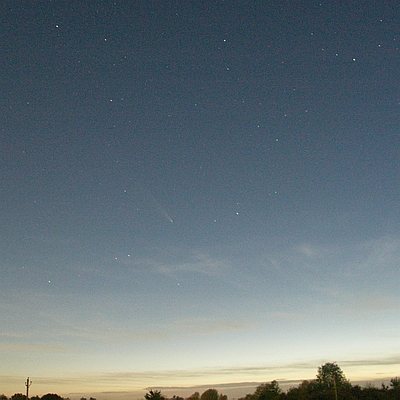 | This was the view at 7:10pm, with the comet just down and left of centre. Corona Borealis is again to top right, with Kornephoros to its left and Rasalhague (Alpha Ophiuchi) the brightest of the three to top left. The group of stars visible to top left in the close-up of the tail above are now to the right of the comet, on the same level, showing just how far it has moved in four days. |
| And here we have a somewhat closer-in view, showing more clearly the group of stars mentioned above - the brightest of which is Unukalhai - and several other patterns. The stars in the upright triangle to the left of the comet (with Marfik at its apex) and the group to top left are all in the constellation Ophiuchus (the Serpent Bearer). Those in the triangle to top right constitute the head of Serpens (the serpent being born by Ophiuchus!) the body of which is constituted from the star below the triangle; the group of stars already mentioned, and the star below the comet. And just to complete the picture, the asteroid Pallas is sitting slightly below and to the left of the brighter star to top left, though it is not visible as it was only at magnitude 10.4 at the time. | 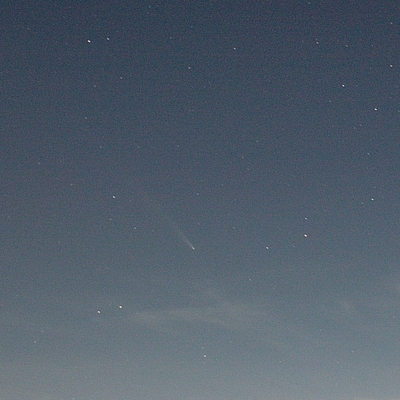 |
 | As with the image of the comet's tail above, this one is also a stack - of four close-up views this time. It has been lightly enhanced to bring out more contrast and converted to greyscale to remove background colouration, allowing us to see that the tail actually extends right across the diagonal of the image - though very faintly to top left. This is a distance of around 10 degrees, less than on the 14th but still impressive. |
Remarkably, the next evening was clear as well so I added my usual extra layers against the chilly damp evening air and strode off up to the allotments in hopes of a further observation session.
| And this is what I saw at 7pm - the same "sky view" as on the 18th so you should be able to recognise all the same stars & star patterns. The comet is now close to the apex of the triangle of stars which it was to the right of the day before but noticeably less bright and with a less impressive tail. |  |
 | The movement of the comet in one day should be clear by comparing the image above with the similar one from the 18th, but to make things easier here's a less wide-angle shot. Click or tap on it to exchange it for the one from the day before. The shift in position is now very obvious. |
| And just to reinforce the point about the tail now being less impressive, here's a close-up image of just the comet as seen on the 19th, generated in the same way as the one for the 18th. Although the tail seems just as extensive when compared to the previous image, in fact it has decreased considerably as this image is at a greater "zoom factor" than the previous one. Click or tap the image to swap them over and then back, and compare the size of the little triangle of stars seen just below the upper portion of the tail on the 18th and part-way along it on the 19th. It is much larger in the frame on the 19th, showing that the tail has in fact reduced in size as compared to its extent on the 18th - it is now down to about 6 degrees. |  |
Evenings were then cloudy for over a week so no further opportunities for observation presented themselves, and of course the comet was getting less bright with every day that passed. However, the witches' brooms swept the skies of Eastern England clear on Hallowe'en (31st October), allowing me to venture out again. Finding the comet was not straightforward, as there were no bright star patterns to go by, but I eventually spotted it in binoculars, allowing me to home in with the camera.
 | As with all the observations above, I've started with a fairly wide-angle view of the western sky, showing the same field of view as previously though with a different set of stars because of the daily rotation of the heavens. The only ones also visible in the earlier images are the three in a dog-leg to right of centre, the brightest of which is Rasalhague, and Marfik hiding in the twilight to bottom right. One thing is dramatically clear - although it was taken at the same clock time as the earlier views (7:10pm), the sky is now much darker. This is due to two factors - the earlier setting time of the Sun after twelve days have passed and the fact that British Summer Time came to an end in that period, meaning that this image was taken an hour after the previous ones by "astronomical time". The darker sky would have made the comet easier to see had it remained unchanged but, as noted above, it was decreasing in brightness quite quickly as it moved away from both the Earth and the Sun. The problem, therefore, is "spot the comet". If you can find the upside-down triangle to lower-left centre and look between the upper-right star in the triangle and the one slightly further up & right you might be able to see it. If you're not sure, click or tap on the image to put a red circle round the comet. Another click will show it against a more enhanced version of the sky, which should enable you to find it more easily now you know where it is. |
| And after you've found the comet, note the slight mistyness extending above and to the left of the upside-down triangle, together with a similar patch at the left of the image. These patches are not clouds or some artifact of my processing but rather the Milky Way - the band of stars not bright enough to be individually identified which mark out a sideways view across our local galaxy. | |
| Here we have a more close-up view of the area in which the comet sits, with the upside-down triangle to lower-left centre and Rasalhague on the right edge. The comet should be easily visible up and to the right of the triangle, about half-way towards the right-most star in the line of three. The fact that it is a comet is however still not apparent. The eye of faith might claim it has a slight greenish colour - always a good indicator of a comet though not definitive - but there's certainly no sign of a tail. |  |
 | It's not until we get very close in and stack together several images that a recognisable tail appears, and then only faintly. Even if I'm being optimistic I would say it now extended to only 11/2 degrees though, as compared to the double figures seen earlier. Its brightness was also way down, having faded to below magnitude 6 and continuing on a downwards trend. |
Given the rapidly decreasing brightness of the comet I decided that further observations would not yield anything more than a slight smudge, if indeed any sightings were possible given that the local weather forecast predicted extensive cloud cover for at least the next week. It was thus time to draw a line under this particular visitor's display.